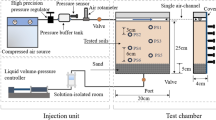Abstract
Purpose
Non-aqueous phase liquid (NAPL) spills may cause soil wettability changes. Soils traditionally water-wet may become NAPL-wet or fractionally wet. Since soil wettability alterations may impact entrapped light NAPL (LNAPL) removal by surfactant flooding, the effects of soil wettability and NAPL contact time were investigated for graded sand and compared to uniform sand. The graded medium was expected to have higher entrapped LNAPL saturations and lower entrapped LNAPL removal after surfactant flooding.
Materials and methods
Capillary pressure–saturation (P c–S) tests (water-LNAPL) and waterflood and surfactant-flood column tests were performed using fine graded sand and compared with results previously reported for the uniform coarse-grained sand. Heptane and LNAPL collected from observation wells at a LNAPL-contaminated oil refinery were used as the ideal NAPL and field LNAPL, respectively. Four experimental conditions were investigated: (1) clean water-wet sand and heptane, (2) clean water-wet sand and field LNAPL, (3) fractionally wet sand and heptane and (4) fractionally wet sand and field LNAPL. LNAPL entrapment after waterflooding and the enhanced entrapped NAPL removal (surfactant-flood minus waterflood saturations) were evaluated after 2 h and 5 days of contact time. Two anionic surfactants, sodium dodecylbenzenesulfonate and a field-site surfactant, were applied at the submicellar concentration of 0.5 g/L.
Results and discussion
The P c–S curves obtained for heptane and the field LNAPL, for a given experimental condition, closely resembled each other owing to the similar interfacial tension behaviour observed for these LNAPLs. In contrast to the results reported previously for the uniform sand, the average entrapped saturations after waterflooding were variable for the finer graded medium; contact time had a significant effect on LNAPL entrapment for the graded clean sand medium with an increase of the entrapped LNAPL saturation from 17 to 28 %. Although the removal for the fractionally wet medium was similar for both sand types, with average removals as high as 45 %, the surfactant-flood column tests with the clean water-wet graded medium did not result in a consistent reduction of the entrapped saturations.
Conclusions
The P c–S relationships demonstrated that heptane and the field LNAPL behave similarly during the P c–S tests. The column experiments revealed differences in entrapped LNAPL saturations among the two sand types as a result of contact time and fractional wettability. Pore structure heterogeneity impacted LNAPL saturations and entrapped LNAPL removal. Overall, soil wettability should be characterized prior to surfactant flooding. The use of anionic surfactants at submicellar concentrations may be beneficial at sites with fractionally wet media.





Similar content being viewed by others
References
Abriola LM, Bradford SA (1998) Experimental investigations of the entrapment and persistence of organic liquid contaminants in the subsurface environment. Environ Health Perspect 106:1083–1095
Ahmed ME, Van Geel PJ (2009) Potential concerns related to using octadecyltrichlorosilane (OTS) in rendering soils and porous ceramics hydrophobic. J Contam Hydrol 110:22–33
Anderson WG (1986) Wettability literature survey—part 2: wettability measurement. J Petrol Technol 38:1246–1262
Bradford SA, Leij FJ (1995) Fractional wettability effects on two-and three-fluid capillary pressure-saturation relations. J Contam Hydrol 20:89–109
Chatzis I, Morrow NR, Lim HT (1983) Magnitude and detailed structure of residual oil saturation. Soc Petrol Eng J 23:311–326
Cho J, Annable MD (2005) Characterization of pore scale NAPL morphology in homogeneous sands as a function of grain size and NAPL dissolution. Chemosphere 61:899–908
Drake SS, O’Carroll DM, Gerhard JI (2013) Wettability contrasts between fresh and weathered diesel fuels. J Contam Hydrol 144:46–57
Dwarakanath V, Jackson RE, Pope GA (2002) Influence of wettability on the recovery of NAPLs from alluvium. Environ Sci Technol 36:227–231
Francisca FM, Rinaldi VA, Santamarina JC (2003) Instability of hydrocarbon films over mineral surfaces: microscale experimental studies. J Environ Eng 129:1120–1128
Jahan K, Balzer S, Mosto P (2008) Toxicity of nonionic surfactants. Environ Toxicol Ii 110:281–290
Lourenço SDN, Wakefield CF, Bryant R, Doerr SH, Morley CP (2012) Wettability assessment of an oil coated soil. In: Mancuso C, Jommi C, D’Onza F (eds) Unsaturated soils: research and applications, vol 2. Springer, Berlin, p 415
Powers SE, Tamblin ME (1995) Wettability of porous media after exposure to synthetic gasolines. J Contam Hydrol 19:105–125
Powers SE, Anckner WH, Seacord TF (1996) Wettability of NAPL-contaminated sands. J Environ Eng 122:889–896
Puentes Jacome LA, van Geel PJ (2013) An initial study on soil wettability effects during entrapped LNAPL removal by surfactant flooding in coarse-grained sand media. J Soils Sediments 13:1001–1011
Renshaw CE, Zynda GD, Fountain JC (1997) Permeability reductions induced by sorption of surfactant. Water Resour Res 33:371–378
van Genuchten MT (1980) Closed-form equation for predicting the hydraulic conductivity of unsaturated soils. Soil Sci Soc Am J 44:892–898
Zheng J, Powers SE (1999) Organic bases in NAPLs and their impact on wettability. J Contam Hydrol 39:161–181
Acknowledgments
This research was possible thanks to the institutional support of the Department of Civil and Environmental Engineering at Carleton University and the Colombian Petroleum Institute. Luz A. Puentes Jácome received financial support from an Organization of American States graduate scholarship. The authors would like to express their gratitude to the following: colleagues and staff at Carleton University, Dr. Dennis O’Carroll and Stephanie Drake from Western University and Engineers Mauricio Cardeñosa Mendoza and Adriana Serrano Santiago from the Colombian Petroleum Institute.
Author information
Authors and Affiliations
Corresponding author
Additional information
Responsible editor: Rainer Horn
Electronic supplementary material
Rights and permissions
About this article
Cite this article
Puentes Jácome, L.A., Van Geel, P.J. Comparative study of the impacts of soil wettability during entrapped LNAPL removal by surfactant flooding in two different sand media. J Soils Sediments 15, 24–31 (2015). https://doi.org/10.1007/s11368-014-0949-6
Received:
Accepted:
Published:
Issue Date:
DOI: https://doi.org/10.1007/s11368-014-0949-6




